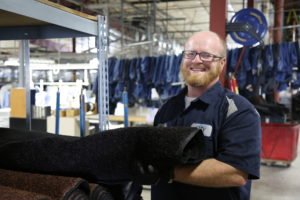The Uniform Cycle in 10 Steps

At CITY, we provide a transparent service. We actively engage with our customers and explain the entire industrial laundering process from start to finish. This supports a healthy organizational culture and relationship with our customers. Below is our 10-step process:
10 Steps
1. The route service representative gathers the uniforms and places them into containers on the route truck.
2. The uniforms are loaded into the truck and transported to CITY’s processing facility.
3. The uniforms are unloaded from the truck and sorted by proper soil/clean separation. They are scanned through the portal using ultra-high frequency technology.
With our UHF tracking system, we can track all garments that are processed within our facility. This allows two important things – a) we can ensure everything that is turned in will be returned; and b) we can track each garment’s life by tracking the number of washings, repairs, and replacements.
4. The uniforms are then placed into a sling to be laundered.
5. The uniforms are laundered according to soil classification and weight. The correct chemical foundation, wash time, and water temperature is assigned. Our facility follows proper washing procedures (detergent formulas, temperature, disinfectant, pH extraction). The uniforms are then transported to the dryer for moisture removal.
6. The uniforms are hung at the hanging station. Garments needing mending are identified and are sent for repair. Garments needing replaced are pulled and exchanged by the stockroom.
7. The uniforms go through the steam tunnel. The garments are steamed with the appropriate kill-temperatures to remove bacteria.
8. Our ultra-high frequency chips are scanned to sort the uniforms via a three-step sort process.
9. The last, and final inspection of the uniforms is completed to ensure a high quality product is going to be delivered to the customer.
10. The freshly cleaned uniforms are loaded and transported back to the customer, meeting all customers’ requirements.
Communicating these steps is an important part of helping our customers understand and envision the entire process.
Have more questions about these steps? Please reach out to one of our district managers.
Comments
Comments are closed.